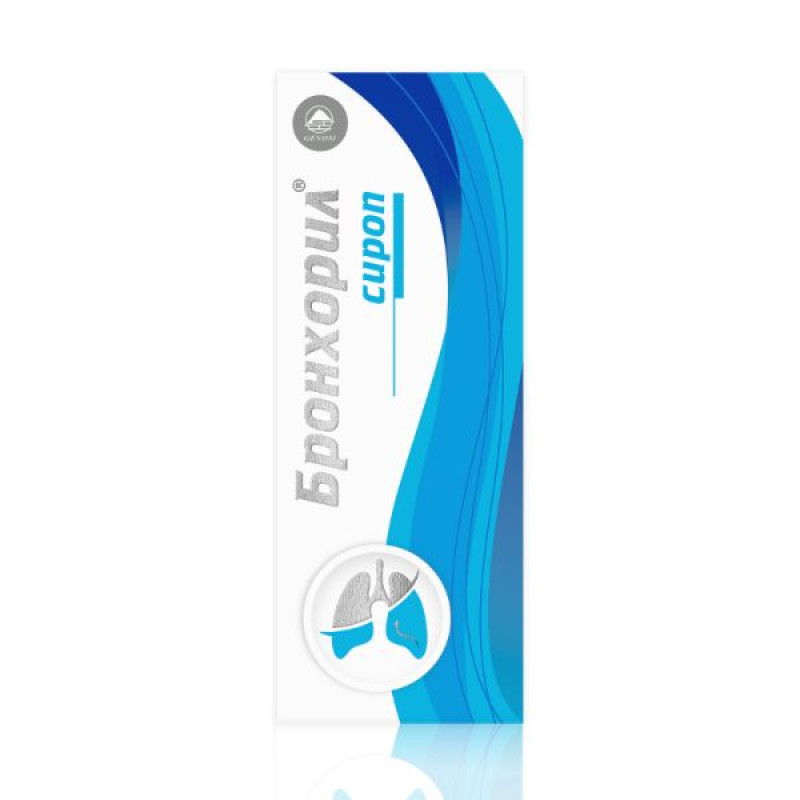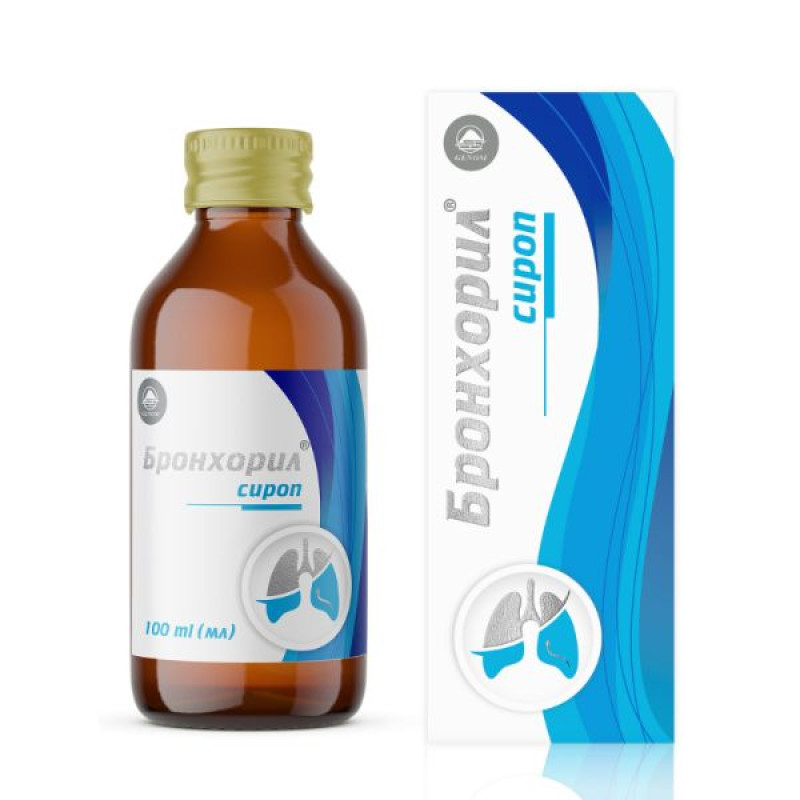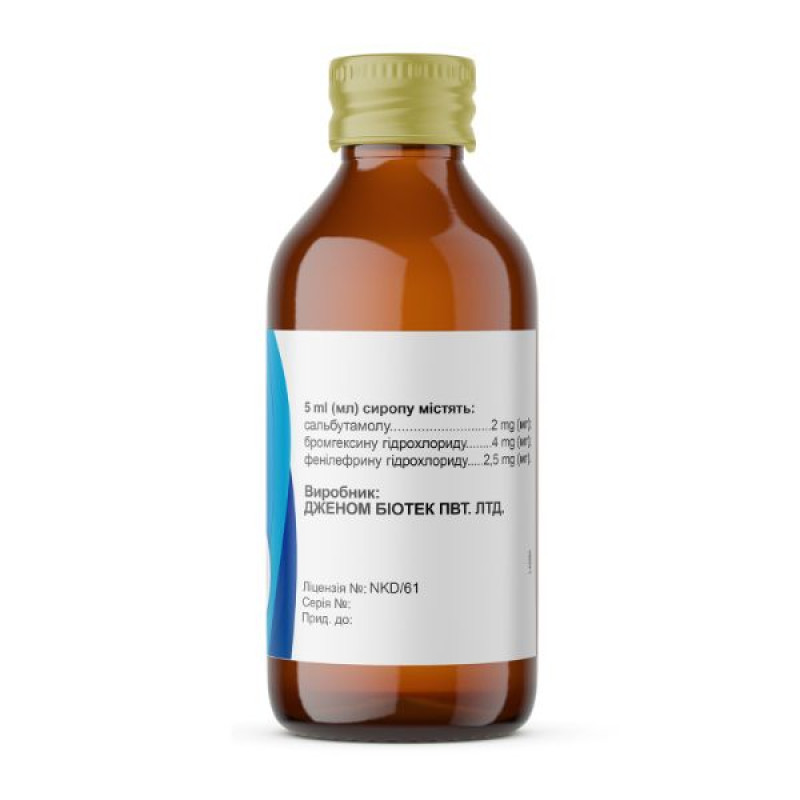Bronchoril syrup 100 ml

Instructions Bronchoril syrup 100 ml
Composition
active ingredients: 5 ml of syrup contain salbutamol sulfate equivalent to salbutamol 2 mg, bromhexine hydrochloride 4 mg, phenylephrine hydrochloride 2.5 mg.
excipients: sucrose; sodium methylparaben (E 219); sodium propylparaben (E 217); glucose solution; sorbitol solution, non-crystallizing (E 420); propylene glycol; citric acid, monohydrate; sodium dihydrogen phosphate dihydrate; disodium edetate; raspberry essence; mixed fruit flavor; Ponceau 4R dye (E 124); purified water.
Dosage form
Syrup.
Main physicochemical properties: transparent, syrupy liquid of pink color, which has a pleasant aroma and a sweet taste.
Pharmacotherapeutic group
Drugs for the treatment of obstructive airway diseases. Adrenergic drugs for systemic use. Selective beta-2-adrenoceptor agonists. ATC code R03C C.
Pharmacological properties
Pharmacodynamics.
Bronchoril® is a combination drug that contains a bronchodilator component (salbutamol), an expectorant component (bromhexine hydrochloride), and a component with a vasoconstrictor and anti-edematous effect on the nasal mucosa (phenylephrine hydrochloride).
Salbutamol ─ β-adrenomimetic with a predominant effect on β2-adrenergic receptors (localized, in particular, in the bronchi, biometry, blood vessels). Prevents and relieves bronchospasm, reduces resistance in the respiratory tract, increases vital capacity of the lungs. Prevents the release of inflammatory mediators (histamine). Improves mucociliary clearance. Practically does not affect β1-adrenergic receptors of the heart. Causes dilation of the coronary arteries. Almost does not reduce blood pressure. The effect of salbutamol develops quickly and lasts 3–4 hours.
Bromhexine has a mucolytic (secretolytic), expectorant and weak antitussive effect. The mucolytic effect is associated with a decrease in the viscosity of bronchial secretions, which is due to the depolymerization and liquefaction of mucoprotein and mucopolysaccharide fibers of the secretion. Bromhexine stimulates the secretory cells of the bronchial mucosa, which produce a secretion containing neutral polysaccharides. Bromhexine stimulates the formation of surfactant - a surface-active substance of lipid-protein-mucopolysaccharide nature, which is synthesized in the cells of the alveoli. Surfactant biosynthesis is disrupted in various bronchopulmonary diseases, which lead to a violation of the stability of alveolar cells, weakening their response to adverse factors. The therapeutic effect of bromhexine is manifested 24–48 hours after the start of treatment.
Phenylephrine hydrochloride is a stimulator of α-adrenergic receptors of blood vessels, has a slight effect on β-adrenergic receptors of the heart. Causes narrowing of the arteries. Due to its vasoconstrictor effect, as well as due to direct stimulation of α-adrenergic receptors of blood vessels of the nasal mucosa, it reduces the phenomena of nasal hyperemia, edema, and improves the patency of the respiratory tract. Reduces inflammatory manifestations in vasomotor and hay fever. Due to the rational combination of salbutamol, bromhexine, and phenylephrine, the drug effectively and quickly reduces the severity of functional disorders of the respiratory system.
Pharmacokinetics.
The pharmacokinetics of Bronchoril® are determined by the pharmacokinetics of the individual components of the drug.
Salbutamol, which is part of the drug, is well absorbed from the gastrointestinal tract (approximately 85%). Binding to plasma proteins is 10%. The maximum concentration is reached after 2–3 hours. The volume of distribution is 3.4 ± 0.6 l/kg of body weight. Metabolized in the liver. The main metabolite is an inactive sulfate conjugate. Salbutamol, which is part of Bronchoril®, passes through the placental barrier and penetrates into breast milk. Adrenomimetic effects may occur in the fetus. The half-life from blood plasma is 2–7 hours. It is excreted mainly in the urine in an unchanged state and as an inactive metabolite. A small amount is excreted in the feces. Most of it is excreted within 72 hours.
Bromhexine is rapidly absorbed from the gastrointestinal tract, metabolized in the liver. Bioavailability is 20%. Maximum plasma concentration is determined after 1 hour. Widely distributed in body tissues, penetrates the blood-brain barrier. In small quantities penetrates the placental barrier and breast milk. About 85–90% is excreted in the urine, mainly in the form of metabolites. The metabolite of bromhexine is ambroxol. The half-life of a small amount of ambroxol is 6.5 hours. The clearance of bromhexine and its metabolites may decrease in patients with severe liver and kidney dysfunction. Phenylephrine is poorly absorbed from the gastrointestinal tract after oral administration. It is metabolized with the participation of monoamine oxidase in the intestinal wall during the "first pass" through the liver. The bioavailability of phenylephrine is low (40%) due to uneven absorption. It is excreted mainly in the urine.
Indication
Symptomatic treatment of respiratory congestion in bronchial asthma, chronic obstructive bronchitis, emphysema, cough and respiratory viral infections.
Contraindication
Hypersensitivity to any of the components of the drug; hyperthyroidism; hypokalemia, gastric and duodenal ulcers, acute pancreatitis; severe liver dysfunction; severe forms of diabetes mellitus; coronary insufficiency, arrhythmia, other severe cardiovascular diseases, severe cardiac conduction disorders, decompensated heart failure; arterial hypertension, severe atherosclerosis, severe coronary artery diseases; epilepsy, pheochromocytoma; angle-closure glaucoma; prostatic hypertrophy, urethral and prostate diseases with difficulty urinating, bladder neck obstruction; pyloroduodenal obstruction, renal failure.
Pregnancy or breastfeeding, children under 4 years of age.
Concomitant use with MAO inhibitors, tricyclic antidepressants, β-blockers or other antihypertensive drugs that suppress or increase appetite, and amphetamine-like psychostimulants.
Interaction with other medicinal products and other types of interactions
Beta-blockers. Salbutamol should not be used with non-selective beta-blockers such as propranolol. Beta-blockers may not only block the bronchodilator effect of beta-agonists, but may also cause bronchospasm in patients with bronchial asthma. Therefore, beta-blockers are contraindicated in patients with asthma. However, in certain circumstances, such as prophylaxis after myocardial infarction, beta-blockers may be considered in patients with asthma. In such cases, they should be used with caution.
Tricyclic antidepressants. Tricyclic antidepressants (e.g. clomipramine, imipramine, amitriptyline) may alter the effects of salbutamol.
Concomitant use of phenylephrine and tricyclic antidepressants increases the risk of arrhythmias.
MAO inhibitors: MAO inhibitors (e.g. rasagiline, selegiline, isocarboxazid, phenelzine, tranylcypromine) may alter the effects of salbutamol.
MAO inhibitors and reversible MAO inhibitors may enhance the effects of phenylephrine.
Concomitant use with MAO inhibitors is contraindicated.
Medicinal products that lower blood potassium levels. Since beta-agonists, including salbutamol, have a hypokalemic effect, concomitant use of medicinal products that lower blood potassium levels and consequently increase the risk of hypokalemia, such as diuretics (e.g. bendroflumethiazide, indapamide, bumetanide, furosemide), digoxin, methylxanthines (e.g. aminophylline) and corticosteroids (e.g. betamethasone, prednisolone, triamcinolone), should be administered with caution after careful benefit-risk assessment, especially in view of the increased risk of cardiac arrhythmias resulting from hypokalemia.
Theophylline. A high risk of hypokalemia occurs when high doses of theophylline are administered simultaneously with high doses of salbutamol. Salbutamol, which is part of Bronchoril® syrup, potentiates the toxic effects of ephedrine and theophylline, reduces the antianginal effect of nitrates. Arterial hypertension may occur with simultaneous use with ganglioblockers, adrenoblockers, rauwolfia alkaloids and methyldopa.
Antibacterial agents. With simultaneous use of the drug and antibiotics (amoxicillin, cefuroxime, erythromycin, doxycycline), with combined use of the drug with sulfonamide drugs, the concentrations of antibiotics and sulfonamides in bronchopulmonary secretions and sputum increase.
Anti-inflammatory drugs. With the simultaneous use of bromhexine and some anti-inflammatory drugs (e.g. salicylates, prednisolone), an increase in the irritating effect on the gastric mucosa is possible.
Antitussives. The combined use of bromhexine and antitussives can cause dangerous sputum stagnation due to suppression of the cough reflex, so this combination should be used with extreme caution.
Antihypertensive drugs. The antihypertensive effect of phenylephrine may reduce or nullify the effects of many antihypertensive drugs.
Antimuscarinics: Severe hypertension may develop after concomitant administration of phenylephrine and atropine or other antimuscarinics.
Antiarrhythmics. Simultaneous administration of phenylephrine and cardiac glycosides, quinidine increases the risk of arrhythmias.
The drug should not be prescribed together with a non-selective β-blocker such as propranolol (a decrease in the therapeutic effect of insulin and oral hypoglycemic agents has been noted with simultaneous use).
Bromhexine is incompatible with alkaline media. Simultaneous use of phenylephrine with ergot alkaloids (ergotamine and methysergide) may increase the risk of developing ergotism.
Simultaneous use of the drug with sympathomimetics is not recommended, since there is an increase in the sympathomimetic effect, the risk of developing side effects from the cardiovascular system increases. Levodopa increases the likelihood of arrhythmias.
Salbutamol should not be used simultaneously with inhalation anesthetics, adrenaline, tricyclic antidepressants and corticosteroids.
Since the drug contains phenylephrine hydrochloride, the drug should not be used with other antihypertensive agents, phenothiazid derivatives (e.g. promethazine), bronchodilator sympathomimetic agents, guanethidine, digitalis preparations, raufolia alkaloids, indomethacin, methyldopa, glucocorticosteroids, drugs that affect appetite, amphetamine-like psychostimulants, anesthetics, ergot alkaloids, other drugs that stimulate the central nervous system, theophylline.
It is possible to increase the vasoconstrictor effect of the drug when used simultaneously with stimulants of labor activity and arrhythmias when used with anesthetics. It is possible to significantly increase blood pressure with simultaneous intravenous administration of ergot alkaloids.
Concomitant use of phenylephrine with β-blockers may lead to arterial hypertension and excessive bradycardia with possible heart block. It should be used with caution with thyroid hormones, drugs that affect cardiac conduction (cardiac glycosides, antiarrhythmic drugs).
Concomitant administration of phenylephrine and other sympathomimetics may lead to additional stimulation of the central nervous system, accompanied by nervousness, irritability, insomnia. Convulsions are also possible. In addition, concomitant administration of other sympathomimetics with phenylephrine may lead to increased vasoconstrictor or cardiovascular effects.
Application features
Bromhexine.
Bromhexine should be used with caution in debilitated patients with asthma.
In case of impaired bronchial motility, accompanied by the formation of a large amount of bronchial secretion (malignant cilia syndrome), bromhexine should be used with extreme caution due to possible stagnation of secretions.
Since bromhexine destroys the mucous barrier of the gastrointestinal tract, the drug should be used with caution in patients with a history of peptic ulcer disease.
In case of impaired renal function, the possibility of accumulation in the liver of metabolites of bromhexine, which is part of the drug, should be taken into account. With prolonged use of the drug, it is recommended to monitor liver function from time to time.
Very rare cases of severe skin reactions (e.g. Stevens-Johnson syndrome, Lyell's syndrome) have been reported with the use of mucolytic agents such as bromhexine. Most of these may be related to the severity of the disease or concomitant use of other drugs. If any symptoms and signs of skin or mucous membrane damage appear, the drug should be discontinued and a doctor should be consulted immediately.
Salbutamol.
Cardiovascular adverse reactions may occur with sympathomimetics, including salbutamol. Isolated post-marketing reports and published data suggest rare cases of myocardial ischemia associated with salbutamol. If patients with cardiac disease (e.g. coronary artery disease, arrhythmia or severe heart failure) develop chest pain or other symptoms of worsening cardiac disease while taking the drug, the drug should be discontinued and a physician consulted. Symptoms such as shortness of breath and chest pain should be carefully evaluated as they may be signs of both respiratory and cardiac disease.
In some patients, as with any other β-adrenergic agonist, clinically significant changes in systolic and diastolic blood pressure may occur. It is known that β-adrenergic agonists can cause ECG changes such as T wave flattening, QT prolongation, and ST segment depression. Therefore, salbutamol should be used with caution in patients with cardiovascular disease, especially in patients with hypertension.
The need to increase the dose of salbutamol indicates worsening asthma control and requires a review of therapy, and if necessary, the appointment of corticosteroids.
The drug should not be used in patients with hypertrophic cardiomyopathy.
Severe hypokalemia may result from treatment with beta-2-agonists. This is mainly observed with parenteral or inhaled forms. Particular attention is paid to patients with acute severe bronchial asthma, since hypokalemia may be potentiated by concomitant use of xanthine derivatives, steroids, diuretics and hypoxia. In this situation, it is recommended to monitor the level of potassium in the blood serum.
As with other beta-adrenergic agonists, salbutamol may cause reversible metabolic changes, such as increased blood sugar levels. Ketoacidosis has been reported in diabetic patients who were unable to compensate for the increased blood glucose levels. Concomitant use of corticosteroids may potentiate this effect.
Phenylephrine
Special caution should be exercised when using the drug in patients with a history of cardiovascular diseases, such as ischemic heart disease, arrhythmias, occlusive vascular diseases, including arteriosclerosis, hypertension, vascular aneurysms. In patients with angina pectoris, anginal pain may increase.
The drug should be used with caution in patients with diabetes.
Simultaneous use with MAO inhibitors is contraindicated. The use of the drug in large doses may reduce the speed of psychomotor reactions. This effect is enhanced by simultaneous use of alcohol, tranquilizers (clozepide, sibazon). It should be used with caution in the treatment of patients receiving large doses of other sympathomimetics.
Aminophyllines can cause central nervous system dysfunction and, as a result, lead to seizures.
Phenylephrine, which is a component of the drug, may have a vasoconstrictor effect, causing cardiovascular failure with manifestations of arterial hypotension. In this regard, the drug should be used with caution in patients over 70 years of age and patients with cardiovascular diseases.
During treatment with the drug, sedative/hypnotic drugs (especially barbiturates) that enhance the sedative effect of antihistamines (chlorpheniramine maleate) should not be used. Use with caution in patients with liver and kidney diseases.
It is forbidden to drink alcohol while taking the drug!
Excipients
This medicinal product contains sucrose, glucose solution, sorbitol solution (E 420). If you have been told by your doctor that you have an intolerance to some sugars, contact your doctor before taking this medicinal product.
Ponceau 4R dye (E 124), sodium methylparaben (E 219) and sodium propylparaben (E 217), which are part of the medicinal product, may cause allergic reactions (possibly delayed).
Use during pregnancy or breastfeeding
The drug is contraindicated during pregnancy or breastfeeding.
Ability to influence reaction speed when driving vehicles or other mechanisms
When taking the drug, you should avoid driving and other activities that require coordination, reaction speed, and concentration.
Method of administration and doses
Administer orally. Dosage should be done using a measuring cap. Adults and children over 14 years of age should take 10 ml 3 times a day.
Children aged 4–6 years - 2.5 ml 3 times a day; children aged 6–8 years - 5 ml 3 times a day; children aged 8–14 years - 7.5 ml 3 times a day.
The duration of treatment is determined individually by the doctor according to the indications and the patient's condition. The maximum period of use without consulting a doctor is 5 days, further use is on the recommendation of a doctor.
Children.
The drug is contraindicated in children under 4 years of age.
Overdose
Possible increase in adverse reactions.
Bromhexine overdose
Symptoms: dizziness, nausea, vomiting, tachycardia, arrhythmia, decreased blood pressure, hypokalemia, agitation, psychotic reactions, dyspeptic disorders, diarrhea, headache, ataxia, diplopia, metabolic acidosis, rapid breathing.
Treatment: induce vomiting, perform gastric lavage (in the first 1–2 hours after ingestion). In case of significant overdose, the cardiovascular system should be monitored and, if necessary, symptomatic therapy should be prescribed. Due to the high degree of binding to plasma proteins, the large volume of distribution and the slow reverse distribution of bromhexine from tissues to the blood, no acceleration of drug excretion should be expected during hemodialysis or forced diuresis.
Salbutamol overdose
Symptoms: The most common signs and symptoms of salbutamol overdose are transient changes pharmacologically induced by β2-agonists, such as tachycardia, tremor, hyperactivity and metabolic disturbances, including hypokalaemia (see sections 4.4 and 4.8). Hypokalaemia may occur as a result of salbutamol overdose, therefore serum potassium levels should be monitored. Lactic acidosis has been reported with high therapeutic doses or overdose of short-acting β2-agonists, therefore serum lactate levels should be monitored. Accordingly, metabolic acidosis should be monitored, particularly in cases of persistent or increasing respiratory distress despite improvement in bronchospasm. Agitation, confusion, respiratory depression, rapid breathing, impaired consciousness, ataxia, diplopia, mild metabolic acidosis, arrhythmias, chest pain, hypotension up to shock, palpitations, tachycardia and severe tremor, especially in the hands. Gastrointestinal complaints, including nausea and vomiting; convulsions, extrasystole, drowsiness, headache, hyperglycemia, abdominal pain, exacerbation of gastric ulcer.
Treatment: Symptomatic therapy, electrocardiographic monitoring is indicated to monitor cardiac function.
Symptoms: psychomotor agitation or depression of the central nervous system, headache, pale skin, dizziness, insomnia, heart rhythm disturbances, tachycardia, reflex bradycardia, extrasystole, tremor, hyperreflexia, nausea, vomiting, irritability, anxiety, increased blood pressure. Arterial hypotension, pain and discomfort in the heart area, palpitations, shortness of breath, non-cardiogenic pulmonary edema, sleep disorders, anxiety, nervousness, inappropriate behavior, psychosis with hallucinations, weakness, anorexia, oliguria, urinary retention, painful or difficult urination, facial flushing, feeling of coldness in the extremities, paresthesia, pale skin, piloerection, increased sweating, hyperglycemia, hypokalemia, peripheral vasoconstriction, decreased blood flow to vital organs, which can lead to deterioration of renal blood supply, metabolic acidosis, increased workload on the heart due to increased total peripheral vascular resistance. Severe consequences of vasoconstriction may be more likely to occur in patients with hypovolemia and severe bradycardia. In severe cases, impaired consciousness, hallucinations, seizures and arrhythmias may occur.
Treatment: Gastric lavage, administration of activated charcoal, symptomatic therapy, use of α-blockers such as phentolamine (in severe hypertension).
Adverse reactions
Immune system disorders: hypersensitivity reactions, including angioedema, anaphylactic shock, fever, chills.
From the side of metabolism: lactic acidosis, hypokalemia.
Gastrointestinal: nausea, abdominal pain, vomiting, diarrhea, anorexia, dry mouth, dyspepsia, exacerbation of gastric and duodenal ulcers, transient increase in serum transaminase activity.
Respiratory system: respiratory disorders, increased cough, bronchospasm, shortness of breath, unproductive cough, increased cough reflex, respiratory distress.
Skin and subcutaneous tissue disorders: skin rash, hyperemia, itching, urticaria, Stevens-Johnson syndrome, Lyell's syndrome, increased sweating.
Cardiovascular system: palpitations, heart pain, chest pain, tachycardia, increased blood pressure, hypotension, collapse, bradycardia, heart rhythm disturbances, including ventricular fibrillation, supraventricular tachycardia and extrasystole; myocardial ischemia (see section "Special warnings and precautions for use").
Vascular disorders: peripheral vasodilation.
From the nervous system and psyche: nervous excitement, feeling of fear, feeling of anxiety, restlessness, headache, dizziness, depression, fever, tremor, general weakness, mydriasis, hyperactivity, muscle cramps.
From the urinary system: urinary retention, difficulty urinating.
Regarding bromhexine: fever, chills, transient increase in serum AST. Some patients may experience a transient increase in blood aminotransferase levels caused by bromhexine.
Regarding salbutamol: oropharyngeal edema, rarely, erythema multiforme, facial edema may occur with oral administration of salbutamol in children.
On the part of the digestive tract: abdominal pain, exacerbation of gastric ulcer/intestinal ulcers, gastralgia, unpleasant taste in the mouth.
Nervous system: tremor, myalgia, dysgeusia, insomnia, oropharyngeal paresthesia.
Respiratory system: Salbutamol may cause paradoxical bronchospasm, which is a life-threatening condition. If this occurs, the drug should be discontinued immediately and alternative treatment should be instituted.
Others: myospasm, feeling of pressure in the muscles, bladder atony, hyperglycemia, thrombocytopenia, metabolic changes such as hypokalemia.
Regarding phenylephrine:
Cardiovascular system: increased blood pressure (especially in patients with arterial hypertension), feeling of hot flashes.
From the nervous system and psyche: sleep disorders, insomnia, drowsiness, anxiety, agitation, hallucinations, convulsions, epileptic seizures, dyskinesia, coma, behavioral changes.
From the liver and biliary system: biliary dyskinesia, hepatitis, jaundice.
Skin and subcutaneous tissue disorders: pallor of the skin, exfoliative dermatitis.
On the part of the organs of vision: dryness of the mucous membrane of the eyes, decreased visual acuity, mydriasis, increased intraocular pressure.
From the blood and lymphatic system: hemolytic anemia, fluctuations in blood glucose levels.
Others: dry nose, weakness.
Expiration date
3 years.
Storage conditions
Store in the original packaging at a temperature not exceeding 25 ° C. Keep out of the reach of children.
Packaging
100 ml in a bottle, 1 bottle with a measuring cap in a cardboard box.
Vacation category
According to the recipe.
Producer
Genom Biotech Pvt. Ltd.
Location of the manufacturer and address of its place of business.
Plot No. D-121, 122, 123, M.I.D.C. Malegaon, Tal. Sinnar, Nashik 422103, Maharashtra, India.
There are no reviews for this product.
There are no reviews for this product, be the first to leave your review.
No questions about this product, be the first and ask your question.















